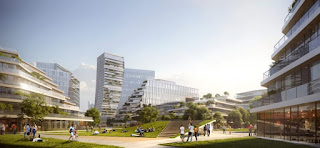Technology giant Tencent
Tencent is building a Monaco-sized 'city of the future' in
Shenzhen
Technology giant Tencent has unveiled plans for an almost
entirely car-free "city of the future," equivalent in size to Monaco,
in the Chinese metropolis of Shenzhen.
Dubbed "Net City," the 2-million-square-meter
(22-million-square-foot) urban development will prioritize pedestrians, green
spaces and self-driving vehicles, according to its designers.
The ambitious city-within-a-city is set to occupy a stretch
of reclaimed land jutting out into the Pearl River estuary. Designed to
accommodate a population of some 80,000 people, the site will primarily serve
Tencent, the conglomerate behind WeChat and China's popular QQ messaging
service.
But as well as providing company residences and offices, the
neighborhood is expected to host shops, schools and other public amenities, and
will be connected to the rest of Shenzhen via road bridges, ferries and the
city's subway system. The American firm behind the master plan, NBBJ, hopes
that the new district's entertainment venues, parks and waterside promenade
will attract visitors from elsewhere in the city.
As such, the plan differs from the enclosed campuses
pioneered by big tech companies in recent years, according to Jonathan Ward, a
design partner at NBBJ.
"It's definitely a destination (and has) a civic
component," he said in a phone interview. "It's not meant to be an
isolated, secure island -- it's a vibrant city. People will walk through it,
they'll connect ... and it will be a vital hub for Shenzhen."
Eliminating the car
With an unusually large vacant plot to work with, NBBJ --
which won an international competition to design the site -- was able to
rethink the car's role in urban planning, Ward said.
"Our main goal was to provide a place where innovation
can really flourish," he explained. "To do that, we tried to minimize
the impact of the car as much as possible.
"Going 'car-free' is still a little bit challenging in
our world, so we spent a lot of time designing the city to be as low-impact as
possible, removing (cars from) where they don't need to be and focusing on
people."
Although regular cars will be able to access some parts of
the neighborhood, the plan centers around a "green corridor" designed
for buses, bikes and autonomous vehicles. The layout eliminates what Ward
called "unnecessary" traffic.
"You don't need one block surrounded by roads -- you
can maybe have eight blocks surrounded by a road, and take away all the ones in
between," he said. "We've been 'subtracting' roads in places where we
think it's perfectly fine for people to walk two minutes longer from a subway
or a (taxi) drop-off.
"And, in those two minutes, you might see something
inspiring, connect to nature or meet a colleague you haven't seen for a while
-- all those things you can see happening in a workplace environment can happen
in the city."
Interconnected planning
As well as integrating with Shenzhen's wider urban fabric,
NBBJ's master plan is designed to offer what it calls an "interconnected,
human-focused organic ecosystem." For Tencent employees, this may mean
eroding the distinction between their work and private lives -- an idea that
has become all the more relevant in light of the Covid-19 pandemic, Ward said.
"Traditional cities are very much siloed, even in the
densest cities where there's more interaction and intermixing," he added.
"But what can happen now is you can start to blur those lines (between
work and play), and bring more interaction between different parts of life.
"You're seeing more blurring of those lines, for better
or for worse. But I think we can make it for the better as we tune this model
going forward," he added.
Elsewhere, the master plan considers environmental
sustainability with rooftop solar panels and elaborate systems for capturing
and reusing wastewater. Planners also looked at projections for future sea
level rises to ensure that buildings are better protected against climate
change.
Tencent isn't the only private company looking to create its
own miniature city. Earlier this year, carmaker Toyota unveiled plans for the
175-acre "Woven City" in the foothills of Mount Fuji, where it will
test autonomous vehicles, smart technology and robot-assisted living. In
Toronto, Sidewalk Labs, a subsidiary Google's parent company Alphabet, was
planning to transform a stretch waterfront into a futuristic new neighborhood,
before it canceled the project citing "economic uncertainty" caused
by Covid-19.
There are also a number of other large-scale developments
being planned in Shenzhen, a city that has exploded in size since 1980, when
the Chinese government named it a "Special Economic Zone." The first
phase of a new business district called Shenzhen Bay Headquarters City, also
being built on reclaimed land, is expected to complete by 2022.
Tencent's Net City will take around seven years to complete,
with construction expected to commence later this year. The dozens of
individual buildings, which will range from one to 30 floors in height, will be
designed by variety of different architecture firms. เว็บพนันออนไลน์



ความคิดเห็น
แสดงความคิดเห็น